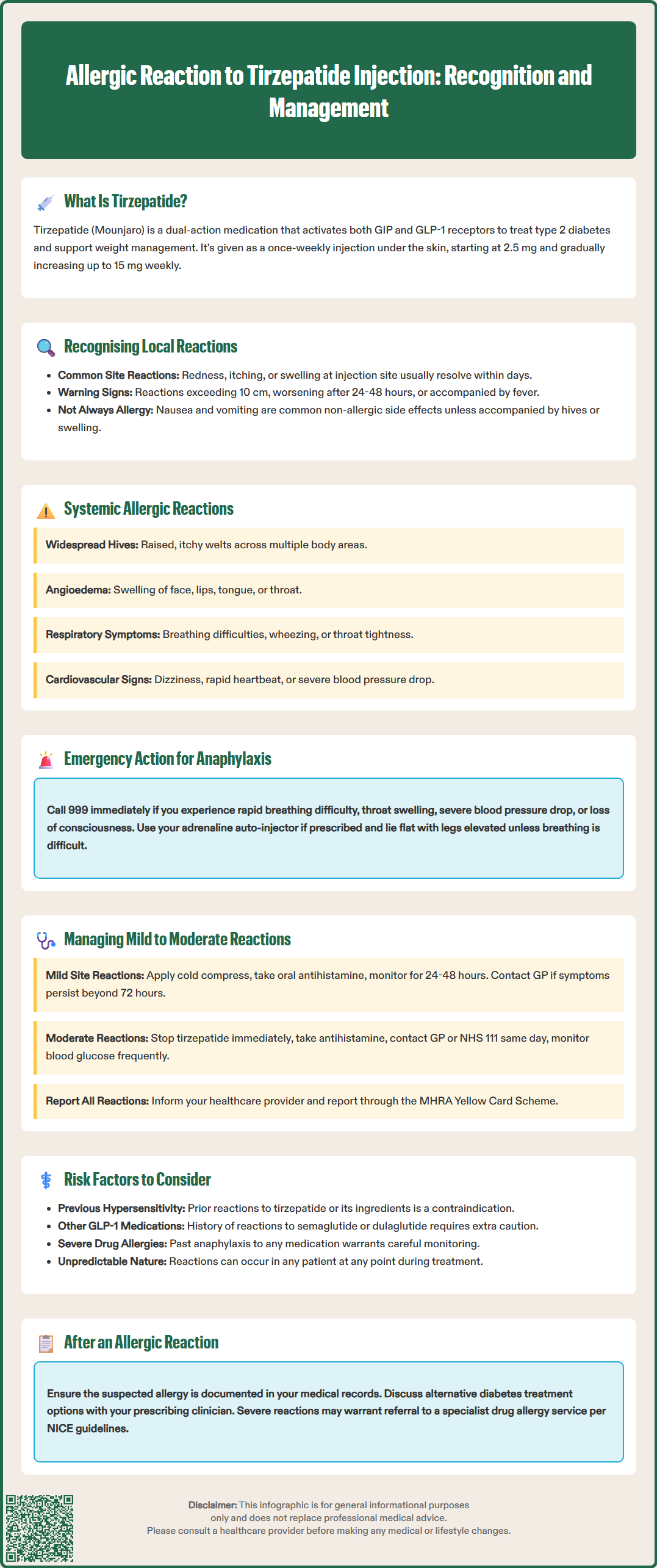LOSE WEIGHT WITH MEDICAL SUPPORT — BUILT FOR MEN
- Your personalised programme is built around medical care, not willpower.
- No generic diets. No guesswork.
- Just science-backed results and expert support.
Find out if you’re eligible

Tirzepatide (Mounjaro) is a dual GIP and GLP-1 receptor agonist used for type 2 diabetes and weight management in the UK. Whilst generally well tolerated, allergic reactions to tirzepatide injection can occur, ranging from mild local injection site reactions to severe systemic hypersensitivity. Recognising the difference between common side effects and true allergic responses is essential for patient safety. This article explores how to identify allergic reactions to tirzepatide, appropriate management steps, and when urgent medical attention is required. Understanding these aspects helps patients and healthcare professionals respond promptly and effectively to potential hypersensitivity events.
Quick Answer: Allergic reactions to tirzepatide injection range from mild local injection site reactions (redness, swelling, itching) to severe systemic hypersensitivity including anaphylaxis, requiring immediate emergency medical attention.
Tirzepatide is a glucose-dependent insulinotropic polypeptide (GIP) and glucagon-like peptide-1 (GLP-1) receptor agonist licensed in the UK for the treatment of type 2 diabetes mellitus. In the UK, it is marketed under the brand name Mounjaro. Tirzepatide has also received authorisation for weight management in adults with obesity or overweight with weight-related comorbidities, though availability and NHS commissioning arrangements may vary.
The medication works through a dual mechanism of action by simultaneously activating both GIP and GLP-1 receptors. This dual agonism enhances insulin secretion in a glucose-dependent manner, meaning insulin is released only when blood glucose levels are elevated. This glucose-dependent action reduces the risk of hypoglycaemia, though this risk increases when tirzepatide is used in combination with insulin or sulfonylureas. Additionally, tirzepatide suppresses glucagon secretion, slows gastric emptying, and promotes satiety through central appetite regulation in the hypothalamus. These combined effects result in improved glycaemic control and weight reduction.
Tirzepatide is administered as a once-weekly subcutaneous injection, typically in the abdomen, thigh, or upper arm. The dosing regimen begins at 2.5 mg weekly for 4 weeks, then increases by 2.5 mg every 4 weeks as tolerated, up to a maximum of 15 mg weekly. This gradual titration helps minimise gastrointestinal adverse effects, which are among the most commonly reported side effects.
It is important to note that tirzepatide is not indicated for type 1 diabetes or diabetic ketoacidosis. It is contraindicated in patients with hypersensitivity to tirzepatide or any of the excipients in the formulation.

Allergic reactions to tirzepatide can range from mild local injection site reactions to severe systemic hypersensitivity responses. It is crucial to distinguish between common injection site reactions and true allergic phenomena, as management strategies differ significantly.
Local injection site reactions are relatively common and typically include redness, itching, swelling, or mild discomfort at the injection site. These reactions usually appear within hours of administration and resolve spontaneously within a few days. Whilst uncomfortable, they do not necessarily indicate a true allergy and often improve with subsequent injections as the body acclimates to the medication. However, if local reactions are larger than 10 cm, worsen after 24-48 hours, or are accompanied by systemic features such as fever, medical advice should be sought as this could indicate infection.
Systemic allergic reactions require immediate medical attention. Signs and symptoms may include:
Widespread urticaria (hives) or pruritic rash extending beyond the injection site
Angioedema affecting the face, lips, tongue, or throat
Respiratory symptoms such as wheezing, shortness of breath, or throat tightness
Dizziness, light-headedness, or syncope
Tachycardia or palpitations
It's important to note that gastrointestinal symptoms such as nausea, vomiting, and abdominal cramping are common non-allergic side effects of tirzepatide. These should only be considered as potential allergic symptoms if they occur alongside other allergic manifestations like urticaria, angioedema, or respiratory symptoms.
Anaphylaxis represents the most severe form of allergic reaction and constitutes a medical emergency. Warning signs include rapid onset of difficulty breathing, swelling of the throat or tongue, severe drop in blood pressure, loss of consciousness, and cardiovascular collapse. Serious hypersensitivity reactions including anaphylaxis and angioedema have been reported with tirzepatide according to the Summary of Product Characteristics.
Patients should be educated to monitor for these symptoms after any dose, as hypersensitivity reactions can occur at any time during treatment. Red flag symptoms requiring urgent medical attention include widespread blistering rash, mucosal ulceration, or high fever. Any concerning symptoms should prompt immediate contact with healthcare services, with severe reactions warranting emergency medical attention via 999 or attendance at the nearest accident and emergency department.
The appropriate response to a suspected allergic reaction to tirzepatide depends on the severity and nature of symptoms. Prompt recognition and appropriate action are essential to prevent progression and ensure patient safety.
For mild local injection site reactions:
Apply a cold compress to the affected area to reduce swelling and discomfort
Avoid rubbing or scratching the injection site
Consider taking an oral antihistamine such as cetirizine or loratadine if itching is bothersome
Monitor the reaction over 24–48 hours; most mild reactions resolve without intervention
Contact your GP or diabetes specialist nurse if symptoms persist beyond 72 hours or worsen
Document the reaction and discuss with your healthcare provider before the next scheduled dose
For moderate systemic reactions (widespread rash, mild angioedema without respiratory compromise):
Discontinue the medication immediately and do not administer further doses
Take an oral antihistamine promptly (note that antihistamines help with skin symptoms but are not a substitute for emergency treatment of breathing or circulation problems)
Contact your GP or NHS 111 for same-day medical advice
Seek urgent medical attention if symptoms progress or do not improve within 1–2 hours
Monitor your blood glucose levels more frequently and contact your diabetes team for advice on managing your diabetes while tirzepatide is withheld, especially if you also take insulin or sulfonylureas
Arrange a follow-up appointment with your prescribing clinician to discuss alternative treatment options
For severe reactions or suspected anaphylaxis:
Call 999 immediately for emergency medical assistance
If you have been prescribed an adrenaline auto-injector (such as EpiPen, Jext, or Emerade), use it without delay according to instructions
If no improvement after 5 minutes and emergency services have not arrived, administer a second dose of adrenaline if available
Lie flat with legs elevated (unless breathing is difficult, in which case sit upright)
Do not attempt to drive yourself to hospital
Inform paramedics or emergency department staff about the tirzepatide injection and timing of administration
Following any allergic reaction, it is essential to report the event to your healthcare provider and through the MHRA Yellow Card Scheme (yellowcard.mhra.gov.uk), which monitors medication safety. Your GP should document the suspected allergy clearly in your medical records and may refer you to a specialist drug allergy service for further assessment. In cases of confirmed allergy, this information should be shared with all healthcare providers and you should be advised to avoid tirzepatide in future.
Whilst allergic reactions to tirzepatide can occur in any patient, certain factors may increase susceptibility or influence the likelihood of hypersensitivity responses. Understanding these risk factors enables more informed prescribing decisions and enhanced patient monitoring.
Previous hypersensitivity to tirzepatide or its excipients represents the most significant risk factor and is a formal contraindication to use. According to the Summary of Product Characteristics, tirzepatide contains sodium phosphate, sodium chloride, sodium hydroxide, hydrochloric acid, and water for injections. Patients with known hypersensitivity to any of these components should not receive tirzepatide.
History of reactions to other injectable medications should be thoroughly documented. While cross-reactivity between tirzepatide and other GLP-1 receptor agonists (such as semaglutide, dulaglutide, or liraglutide) is theoretically possible, the evidence establishing such cross-sensitivity is limited. Patients with previous reactions to other incretin-based therapies should discuss this with their healthcare provider, who may consider specialist advice before prescribing tirzepatide.
Prior severe drug allergies or anaphylaxis to any medication may warrant additional caution and monitoring, particularly during initial treatment. A thorough allergy history should be obtained before initiating tirzepatide, with clear documentation of the nature and severity of previous reactions.
It is important to note that the absence of risk factors does not eliminate the possibility of allergic reactions, as hypersensitivity can develop unpredictably in any patient. Healthcare professionals should conduct individualised assessments, provide clear patient education about recognition and management of allergic symptoms, and ensure accessible follow-up support.
Following any suspected allergic reaction to tirzepatide, patients should be referred to their GP for documentation in their medical records. In cases of severe reactions, referral to a specialist drug allergy service may be appropriate, in line with NICE Clinical Guideline 183 on drug allergy diagnosis and management.
Allergic reactions can occur at any time during treatment with tirzepatide. Local injection site reactions typically appear within hours of administration, whilst systemic hypersensitivity reactions including anaphylaxis can develop rapidly, often within minutes to hours after injection.
If you develop a widespread rash, urticaria, or any rash accompanied by breathing difficulties, facial swelling, or feeling unwell, discontinue tirzepatide immediately and seek urgent medical advice. Mild local injection site redness alone may not require stopping, but discuss with your healthcare provider before the next dose.
This depends on which medication caused the previous reaction and the nature of that reaction. Discuss your allergy history thoroughly with your prescribing clinician, who may seek specialist advice before initiating tirzepatide, particularly if you have had reactions to other GLP-1 receptor agonists or injectable therapies.
All medical content on this blog is created based on reputable, evidence-based sources and reviewed regularly for accuracy and relevance. While we strive to keep content up to date with the latest research and clinical guidelines, it is intended for general informational purposes only.
DisclaimerThis content is not a substitute for professional medical advice, diagnosis, or treatment. Always consult a qualified healthcare professional with any medical questions or concerns. Use of the information is at your own risk, and we are not responsible for any consequences resulting from its use.